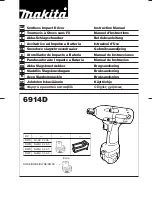
AIR SUPPLY
Tools of this type, operate on a wide range of air pressures. It is recommended that
air pressure to this tool does not exceed 90 PSI, at the tool when running. Higher
pressure and unclean air, will shorten the tools’ life because of faster wear, and
could be a safety hazard.
Water in the air line will cause damage to the tool, ensure it is properly maintained
at all times.
Filter
Filter / Regulator
Air
Supply
Airline Hose
Airline Hose
Regulator
Fig.1
OPERATION
Select an appropriate impact socket, which must be in good condition, and fits
the tool shank and nut closely. (
NEVER
use standard hand sockets)
Forward and Reverse is obtained by pushing the lever, on the side of the tool, to
the ‘F’ or ‘R’ position.
Tool power is adjusted by turning the knob, at the base of the tool, to one of the
settings etched in the knob. The lower the number, the lower the power setting.
Turn the regulator to its lowest setting, then apply the wrench to a nut or bolt of
known tightness (or torque setting), size, thread pitch, and thread condition as
those on the job.
Start the tool, in the
FORWARD
position, and gradually turn the regulator until the
nut or bolt moves very slightly
in the direction in which it was set.
The tool is now set
to duplicate that tightness. For future use, note that setting.
When critical torque values are not required, turn nut or bolt until it fits snugly, and
then turn a further one quarter to one half a turn - slightly more if gaskets are used
between surfaces.
For additional power on disassembly work, turn the regulator to its highest setting.
This tool is rated at 3/4" bolt size, and is downgraded for spring ‘U’ bolts, tie bolts,
long cap screws, double depth nuts, badly rusted conditions, and spring loaded
fasteners as these conditions absorb much of the impact power.
Soak rusted nuts in penetrating oil, and break rust seal before turning off with the tool.
IMPORTANT: Where the torque setting is critical, the final tightening of nuts or bolts,
must be by hand using a properly calibrated torque wrench.
The recommended procedure to con-
nect this tool to an air supply, is shown at
fig.1 below. The air inlet used for con-
necting air supply, has a standard ¼”
BSP thread.
Line pressure, or hose inside diameter,
should be increased to compensate for
unusually long air hoses (over 10m).
Minimum hose diameter should be
8mm (5/16") ID., and fittings should
have the same inside dimensions.
5

























